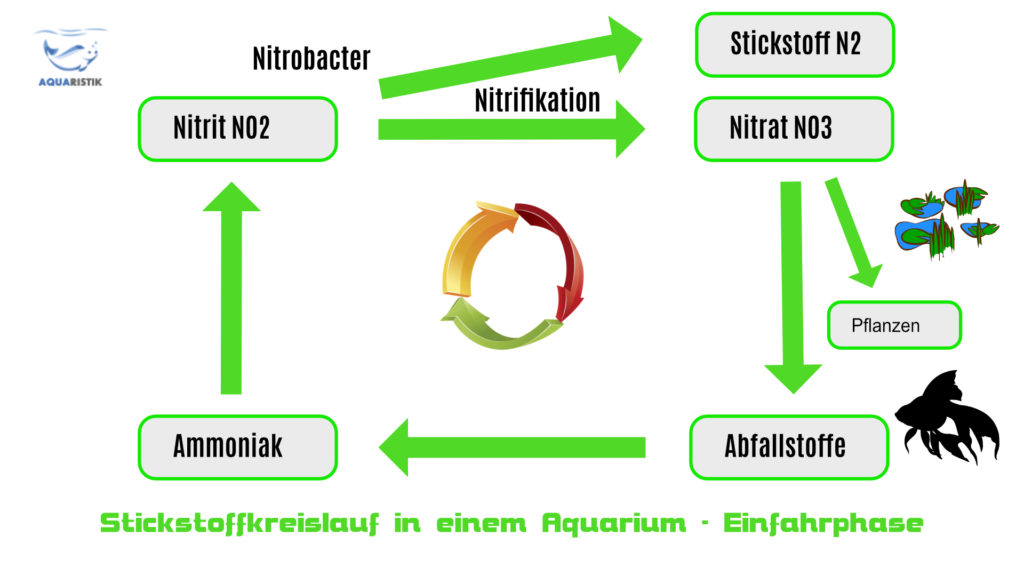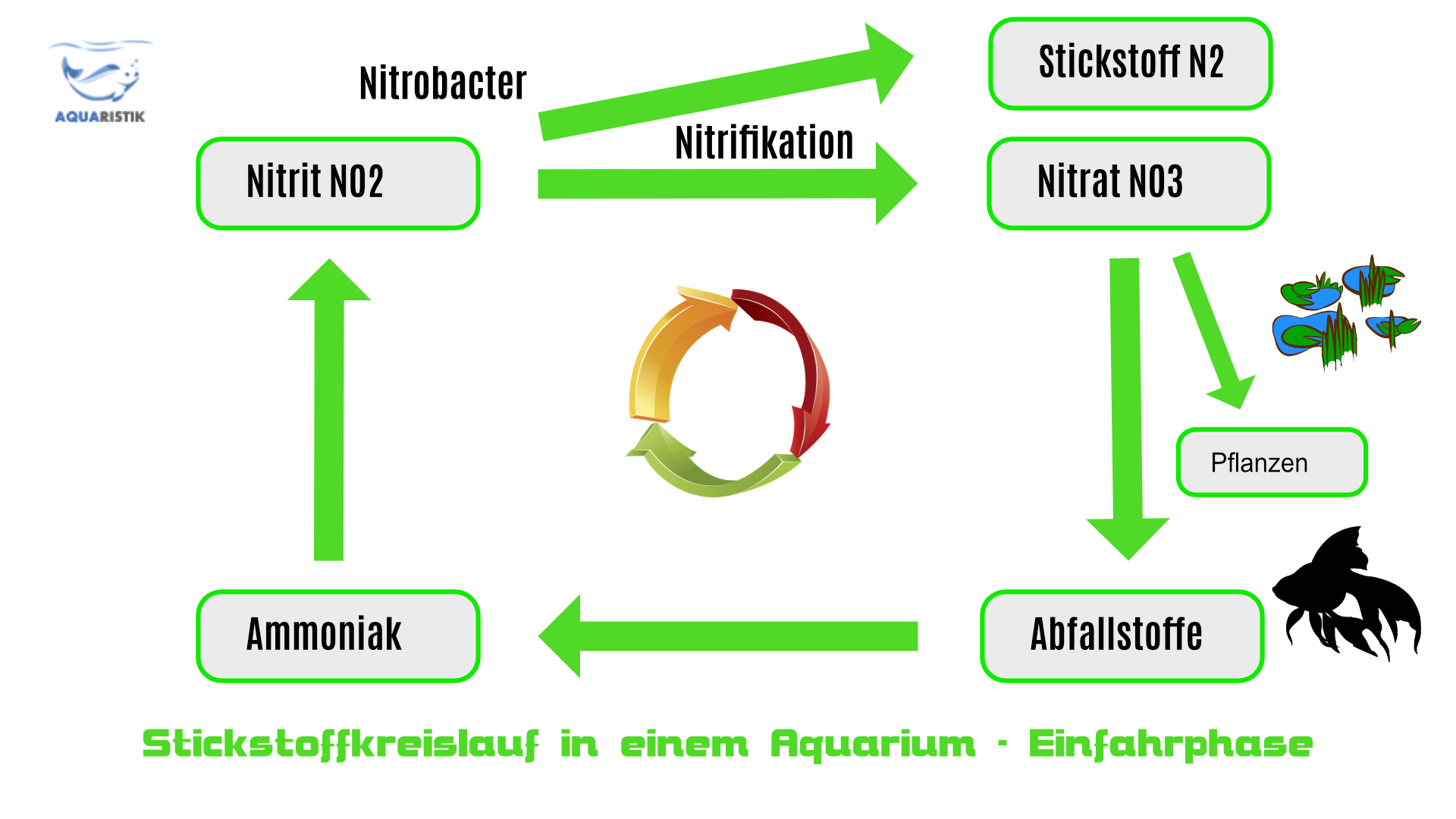Table of Contents
Ammonia / ammonium / nitrite / nitrate and nitrabacter / nitrosomas - Who alternating circuit in the aquarium
Before we can go into the above questions in detail, one must first understand what is happening in an aquarium when we speak of the cycle, or rather the nitrogen cycle. We describe them here in bullet points and in a simplified representation:
- Fish and plants produce organic waste
- These cause ammonium and ammonia
- This is for ornamental fish very poisonus
- With the help of Nitrosoma bacteria, the ammonia is converted into nitrite NO3
- Nitrite is also dangerous for fish. Nitrite is converted into nitrate NO3 by Nitrobacter (nitrification).
- Plants use nitrate as fertilizer
So much for the metabolic cycle in an aquarium. Arguably the most important things in this cycle are the bacteria Nitrosomas and Nitrobacter. Without them, toxic substances such as ammonia and nitrite are not converted and broken down.
Once you have understood this cycle, you can quickly see what happens at the beginning of the start-up phase of an aquarium.
To make things even clearer, we made a graphic. If you still have questions, just ask in the forum or send us an email.
Simplified representation of the nitrogen cycle in the aquarium

What does running in an aquarium mean – running-in phase
As already described above, running-in is the time a newly set up aquarium needs to allow the necessary bacteria to develop. During this time, the aquarium is retracted, i.e. made ready for later stocking and the creation of balance.
How do these Nitrobacter or Nitrosomas bacteria develop?
If you have understood the upper cycle, then you should now also know that it ultimately depends on how quickly the bacteria need to convert the toxic substances into non-toxic substances in order to settle.
Nitrosomas and Nitrobacter develop gradually and how quickly this happens depends on many factors.
How long does this start-up phase last?
This question depends on many factors and cannot be answered with a fixed period of time. As already described above, this is dependent on the bacteria Nitrosomas and Nitrobacter. The influencing factors can be, for example, the following:
- Setup of the aquarium
- How many plants are in the tank
- What filter was used
- Is there already pre-loaded water from another basin
- Is helped with bacteria vaccination
- How big is the aquarium
- How is the tap water
A solid Duration is difficult to name. The maximum guide values that can be given are:
What is the nitrite peak?
In the context of the running-in phase, one reads again and again about the nitrite peak. But what do you mean by that? The nitrite peak is the period or point where the nitrite level is at its highest and then falls to zero. This is where the full power and effect of the Nitrobacter bacteria began to break down.
Can I determine the exact point of the end of the break-in period?
That's fine! However, you have to know when nitrite peak takes place. In order to be able to determine this, you should take it every day water values, especially the nitrite level measure. to serve Strip or droplet tests.
However, one thing right away. The peak cannot always be precisely determined. In our experience, we were very often able to find almost no peak. Therefore, it is important to be careful with this method and not to rely on it completely.
When can I now use the fish safely?
Never. - Yes you've read correctly. There is always a certain residual risk. Nevertheless, there are different methods and every aquarist has his own way. Beginners should focus primarily on the 1. Possibility concentrate, as this is considered to be the safest.
Possibility 1: Wait until after the nitrite peak and fully retract the aquarium
Beginners should take their time. Unfortunately, this is quite difficult for beginners. They want to use the fish and start aquaristics as soon as possible. However, this is the wrong way.
Measure the nitrite value daily and wait for the nitrite peak. Should you not be able to determine this after 4-6 weeks, then you can gradually start introducing the fish.
In the beginning, enjoy the growth of your plants and find out all the exciting things aquaristics have to offer.
Possibility 2: The middle course - onset after 1 week
Again and again one reads from aquarists who already use the fish after one week. That can also work well, but you have to pay attention to a few things. As with method 1, you have to measure the values exactly every day and you must not lose sight of them. The balance in the pool can change quickly. In addition, the fish must always be observed very closely. Gasp for air, put on the fins, what do the eyes look like or how is the behavior of the fish? Here you should have some experience and know exactly how the respective fish species reacts and behaves. Nitrite sensitivities should be known exactly.
If you observe something conspicuous, you have to react immediately.
A nearly 90 percent Water change should be carried out in order to reduce the nitrite content quickly. This can even become necessary every day.
Possibility 3: Use fish immediately - only something for professionals
As in option 2, it is also important to measure and observe precisely here. However, it's not exactly a sensible method to start with the fish right from the start. Suspended matter and various initial turbidities are not out of the water yet. That's why they never buy plants and fish together.
How can I shorten the break-in phase?
One thing right away. Whether the following tips and tricks really help varies from case to case. Nevertheless, some things have proven themselves, but also harbor certain risks.
- Take water from another aquarium: This could already contain bacteria, although one thing must be said right away. The Nitrobacter are usually only very small in the water, but can be found more on furnishings. There is also a risk of bringing algae spores or other roughage into the new aquarium.
- Helping out with commercially available bacteria
- Helping out with used filter media from other pools. Here, too, it can happen that you also bring unwanted things into the aquarium.
- Inoculation with bacteria: Inoculate filter media with certain preparations
Can I use certain types of fish, shrimp or snails faster?
Yes, there are some differences here too. So it may be that certain fish are less sensitive to nitrite and do not show any problems at low nitrite values such as 1 mg/l. Others are much more sensitive. Catfish and certain other algae eaters are usually the first residents in a new aquarium.
Snails, for example, can move into the tank right from the start.
You can find everything about snails here:
All about snails in the aquarium
Finally, a few tips on what to keep in mind after the start-up phase or the start-up of the aquarium:
Important information about the trimming:
- Always use gradually
- Use rather insensitive fish at first
- Check the values again and again after the fish have been introduced
- If there are problems, change the water immediately, shorten the water change intervals
All to Water changes are here.
In particular, you can find in our guide to Water change during break-in information here.






